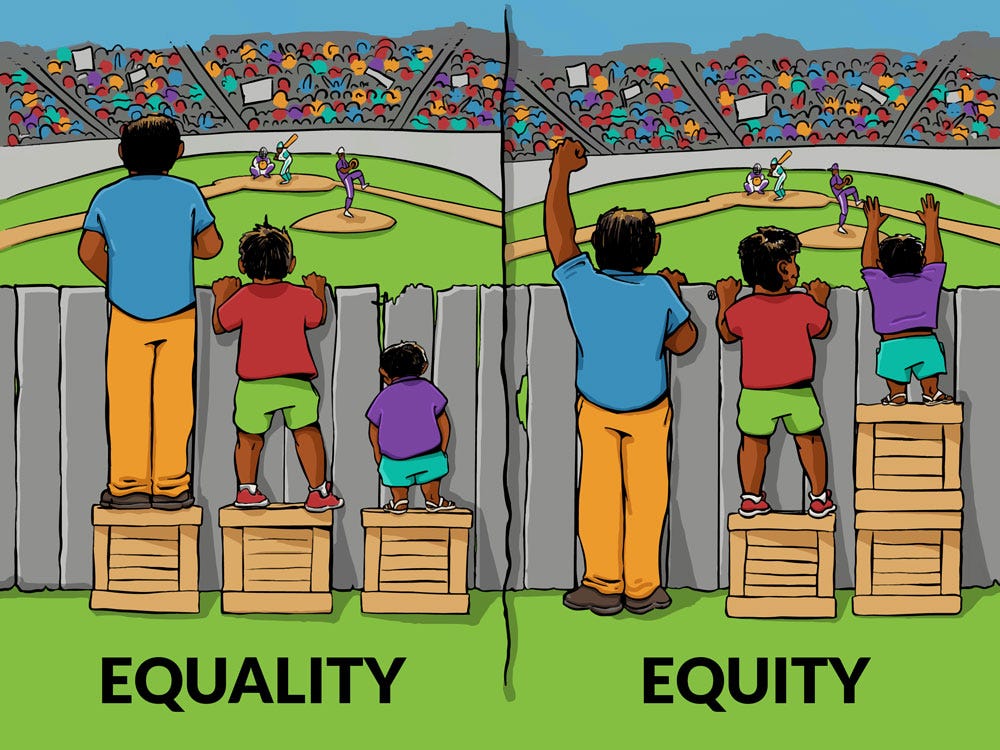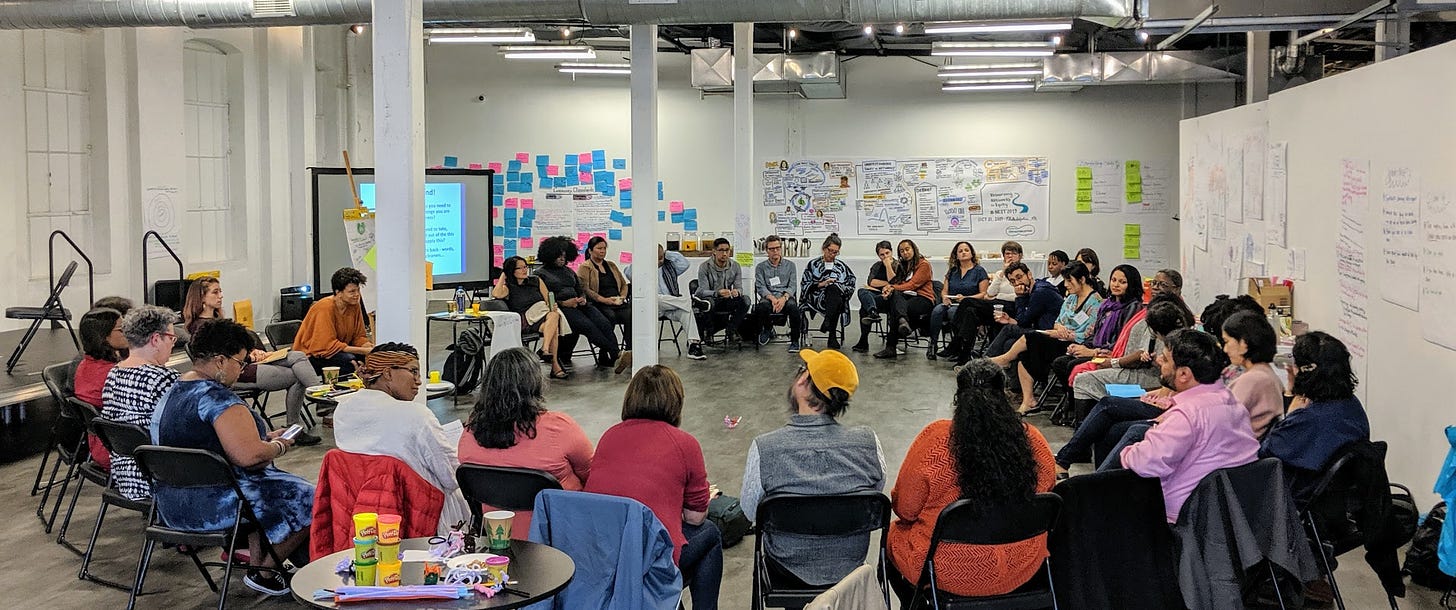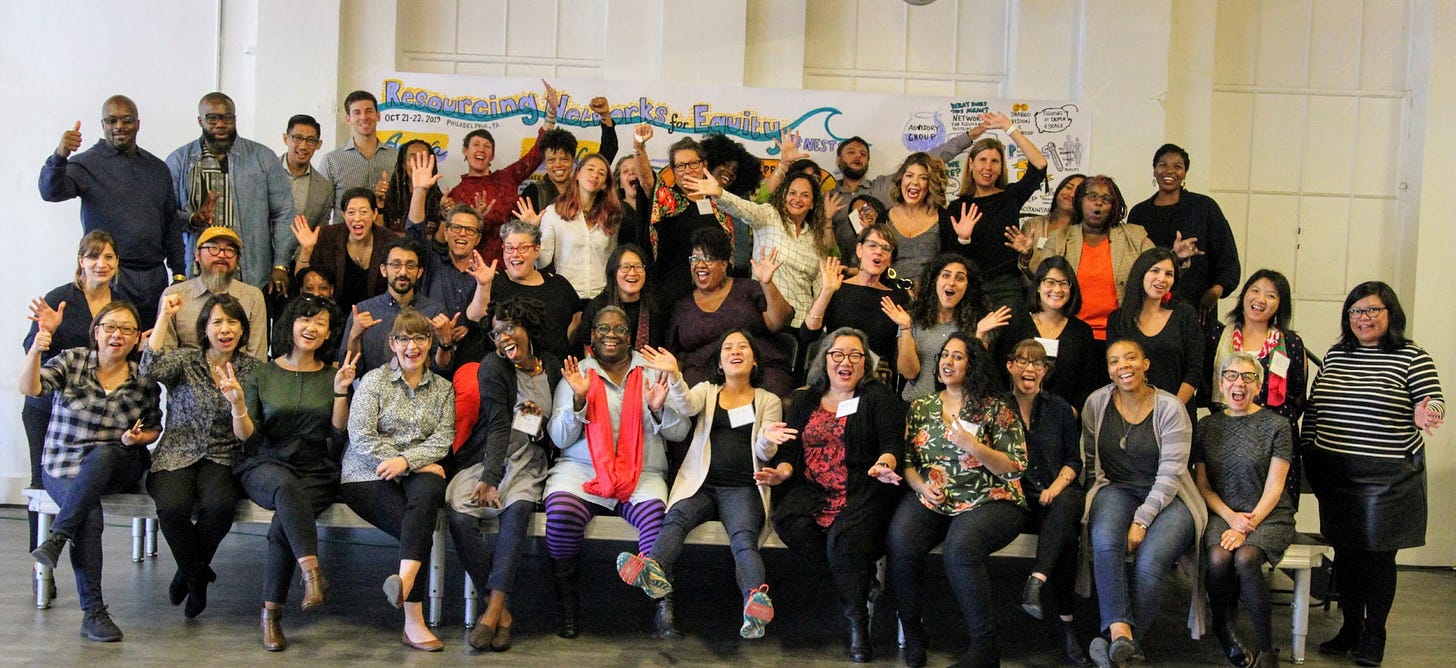Resourcing networks for transforming systems
Reflections from 48 hours in the City of Brotherly Love
I was grateful to receive an invitation recently to a convening "of people working with networks for equitable systems change," held Oct 21-22 in Philadelphia. The gathering was organized around this inquiry: how do we better resource networks that are striving to center equity in their work to transform systems?
There’s a lot going on in that sentence, so let me unpack it. I think of it as a series of concentric circles.
The biggest circle is the growing discipline and ecosystem around exploring “networks” as a potentially valuable mechanism for navigating complexity.
Within that broader ecosystem of networks is a second smaller circle: a subset of practitioners who see networks as essential for bringing about systems transformation: e.g. not just a more efficient means to an end (navigating complexity) but for fundamentally and permanently altering the status quo.
Within that is still a third circle: those of us who are interested in transforming the status quo toward social justice (e.g. this is not about the Silicon Valley “disruption” of Facebook and Uber, but about the transformative potential of networks that can link movements like #MeToo and the Movement for Black Lives, or the social justice movements in Hong Kong to those in Lebanon and Chile, say). This is where the “equity” piece comes in.
Our convening focused on networks in this third category: those striving to bring about collective liberation (at various levels and through various means, but ultimately with a generally shared purpose).
Because by their very nature networks and practitioners in this third category threaten the status quo, they are difficult to resource: our existing capitalist system does not generally fund efforts to explore alternatives to that capitalist system--even when it recognizes that the current system is not working. As Upton Sinclair famously noted: “It can be difficult to get a man to understand what his job depends on him not understanding.” This scene from MoneyBall really resonates for me on this point:
Hence this convening: what might it look like to better resource these networks? What are the barriers (in addition to the obvious one named here)? What are emerging good practices that we can follow and explore?
I was really excited about the convening and the potential it held. First, it was convened by Change Elemental, an organization for which I have tremendous respect and that has been at the forefront of thought and practice about networks and system transformation. Second, the design team was a “who’s who” of people whose work I see as at the cutting edge of practice in this emerging ecosystem: I was confident anything they devoted collective energy to would be worth the trip. Third, when the organizers shared the participant list the week before the event I found collected an incredible group of folks: some of the best movement strategists, network-builders, and practitioners in the country. (Indeed, I felt simultaneously honored and deeply humbled to be in such company).
It’s an unenviable task to usher 50+ people through this kind of complexity over the course of two short days: to capture and channel the collective wisdom and experience in the room into something that we can carry forward. I walked in already carrying the anxiety that I always feel in gatherings like this: so many good people, so much possibility, so little time! As an intuitive connector and network-builder, I felt like a kid in a candy store: so curious about everyone’s stories, their current work, their learnings, the possibilities for collaboration. Where to begin?
Since I am also helping weave a network across many lines of complexity and difference, I was attentive to process and to learning from the art of the convening: how do we move people though a shared journey to enable effective collaboration?
Initial thoughts, in no particular order:
Process Points
Diversity in solidarity. As always in these spaces, it was majority female and majority people of color (of the 50+ participants, about ten were men, and about ten were white; I was one of two white men). This is to the great credit of the women of color who continue to be at the forefront of our movements for social transformation, and yet speaks in my mind to how far we still have to go. Maybe this is a metric of progress toward liberation? When it’s no longer a surprise to see white men co-conspiring in liberatory practice.
How difficult it is to create a container that can effectively serve multiple audiences. We had in the room at least three different groups: advanced practitioners (the aforementioned people at the cutting edge of this discipline, often highlighted in presenting roles); people deeply grounded in one aspect but not necessarily the others (e.g. someone who gets equity but is new to networks); and funders (who themselves generally fit one of the two other categories). The consequence was that each group felt somewhat in tension with the others: the leading lights were chomping at the bit to push forward; those trying to grasp a new concept felt left behind; and people weren’t quite sure what to do with the funders. (Obviously I’m speaking for my own perceptions here).
Finding common language. This tension played out to some extent around terminology: what’s the difference between a “network” and a “movement”? What do we mean when we talk about “emergence”? There were some people in the room who could teach an entire class on these subjects; others who were trying on a new concept for the first time.
When the conditions are right, we can move really fast. The counterpoint to the above: for all of our wonderful diversity, it’s amazing how easy it is to build together when we have a common foundation of trust and shared practice. I felt deep solidarity with everyone there, felt so much appreciation for both what people were doing in their work and how they were showing up in the world (and in the room), and generally felt welcomed by everyone I engaged with. Though we came from very different background (identities, sectors, experience, etc.) we shared a common high-level goal and an equally important way of being (shared values or principles).
The importance of naming our shared values at the outset. The facilitators offered us some “guardrails for how we want to be in this space.” Who doesn’t want tender transparency? (pic below, though it’s probably hard to read) I also loved the notion of re-spect, hearkening back to the latin origins of the word and it’s meaning “to see again.”
The value of small groups. Yet another reminder of how important it is to have breakout sessions to engage in smaller groups: even the best plenary ultimately saps energy. We are meant to be in relationship and dialogue, not passive absorption. The facilitators organized us into “tree groups” (chestnut, elm, etc) that served as touchpoints over the two days. I really liked it: a chance to go a little deeper with people, to put more of our humanity on the table. Dare I say you can never have too much small group time?
Shout-out to “graphic storyboarding.” (Is that the right term?) Change Elemental partnered with Brandon Black, a Cincinnati-based artist who had the most amazing talent for capturing our meandering conversations in a beautiful graphic in real time. I didn’t even realize I was missing that skillset/contribution in my life, but it was super valuable to have on hand and feels mission-critical for future convenings.
Cool nuggets that I’m still sitting with
Tender transparency in practice around money. I really appreciated the intentionality and transparency with which the facilitators talked about money. An opening session was devoted to sharing their struggles and learning with administering an “equity fund”: a communal pot of dollars that the funder made available to help everyone attend (shout-out to Robert Wood Johnson Foundation, and specifically Matt Pierce — who sadly couldn’t attend the party he helped plan :-( and Uma Viswanathan for making this possible). Money is hard — super hard. And they went there, and created space for another tenderly transparent moment later that another participant shared about their experience sharing/distributing money within a nascent network.
Meditations on hospitality. My tree group played with an extended metaphor around hospitality that I found really attractive: how do we host people? What creates an inviting space? What does it look like to be a good host, a good guest, and to transcend those roles to move into co-creation together?
Comfort, stretch, panic. Motaz Attalla introduced a framework that I immediately connected with, detailing levels of how people respond to change. The implication for our work was how to keep people in stretch space: not in the complacency of comfort or the paralysis of panic, but in a place where they are open to growth.
Themes for continued exploration
How we do and what we do are inextricably related. We had a lot of resonance around this core belief that I now see everywhere in movement space and that feels very right to the moment we’re in (elsewhere I talk about this as the need for means and ends to align). I’m actually really excited about this insight, for as Jean Shinoda Bolen notes: “When a critical number of people change how they think and behave, the culture does also, and a new era begins.”
The system we are trying to disrupt lives within us. Ah, internalized oppression! Some really powerful conversations around this concept.
The line that is still reverberating for me (a few of us winced when she said it), reacting to this popular meme (shoutout to Angus Maguire) around equity “Sometimes for us — people of color — “equity” looks like cutting each other’s legs off so we’re all short.” How do we remain attentive to our own healing even as we focus on others?
It’s about embodiment… and practice. Connecting the two above: we need to get into our bodies. When our bodies are the site of trauma (intergenerational and lived), we can’t heal ourselves only in our minds. It’s also about what we do (as Movement Generation reminds us: what the hands do, the heart learns). Healing is a full-body enterprise. I’m excited about this area of growth for myself: it feels so right, and so counter to everything I’ve been conditioned into. Somatics, here I come!
Prefiguring the world we want: the need for radical imagination. There was also lots of resonance around the need for imagination. As Gloria Anzaldua reminds us:
Empowerment comes from ideas—our revolution is fought with concepts, not with guns, and it is fueled by vision. By focusing on what we want to happen we change the present. The healing images and narratives we imagine will eventually materialize. -from the preface to The Bridge We Call Home
The notion of means/ends is connected here. Acting out the world we want is a way of “prefiguring” it: showing what it looks like so that people can see for themselves… and join us. I’m encouraged to see this strand of thinking, which continues to feel hugely important and under-resourced in this moment.
What time is it on the clock of the world? This concept of imagination for me connects here. People didn’t explicitly cite Grace Lee Boggs, but that’s what this theme brought up for me. We returned repeatedly to this question: how do we recognize and honor our ancestors - those whose shoulders we stand on - and keep our eyes and minds on our descendants… those who will reap what we sow? And what, therefore, does that mean for how we strategize and act in the present?
We still struggle with scale. The question remains: how do we reach Bolen’s “critical number”? We have a sense that networks are part of that answer, that so too are movements. But we don’t actually know: that seems to me one of the major questions that we are collectively grappling with. We actually didn’t devote a ton of time to it specifically in conversation, but for me it seemed to lurk beneath a number of our conversations (and felt more acute to me as one of only 2-3 people in the room intentionally focused on organizing internationally).
Power dynamics are barriers, but we can surmount them. One of our principles was “bringing our whole selves” and not being defined by our organizational roles. There is a notorious divide between funders and grantees in nonprofit/movement spaces, for very good and ongoing reasons. And it was still there for us. BUT: our funders were/are amazing. These are people who have been in the work for years, and have worn many hats (a funder today might have been a movement practitioner last year). I appreciated learning from and with them, and it affirmed for me my own instinct in navigating these dynamics in my work: find the people. They exist. Organizations are not monoliths. I’m not sure how everyone felt at the end, but of the many spaces I’ve been in that bring funders/movements together, this felt better than most.
Solidarity with accountability. A few folks talked about pairing these terms in a way I found really attractive. Yes, of course: solidarity is premised on mutuality, and what is mutuality if not a relationship anchored in the promise of reciprocity? One person (a woman of color) asked me directly a question I found intriguingly provocative: “who are you accountable to?” Good question, and worthy of deeper exploration.
Boundaries vs spaciousness. I encountered a recurrent theme around managing the tension between expansiveness (incorporating many things, seeking connections) and the need for boundaries (defining an ecosystem within which we’re operating). I can’t remember where I saw this now, but someone noted that even ecosystems have their boundaries: fish don’t swim in forests. It’s also a timing/process question: when do we turn from opening up to consolidating and focusing.
Building a network of networks. This is the particular area I’m most focused on: the meta- level. To me it’s tied to the boundaries question: you do actually need different diverse ecosystems (I think of the major organs in a human body). But you also need to link those organs into a larger whole… that is the network of networks. We bounced between levels of conversation, but spent most of our time on how we build/strengthen/sustain a single network… that’s hard enough. We still struggle to figure out how to connect our own emergent networks to others.
Hierarchy is not the problem: domination is the problem. This is definitely a growth edge for me and something I’m thinking about with increasing attention. The opposite of oppressive structures is not no structure. How do we create non-coercive structures in our networks? For me this is closely tied to the notion of attraction: how do we convene from a place of invitation, not compulsion?
A couple quotes
Part of our own process of decolonization is renouncing the notion that ‘I’ is separate from the ‘we’” - Allen Kwabena Frimpong
“We need to slow down. We don’t have much time.” - Allen again, attributed to Abraham Lateiner
Final thoughts
I love being around WOEs (what adrienne maree brown calls people who are “working on excellence”). As taxing as it is to engage on issues of this magnitude and depth, and as hard as it is to be constantly stretching every aspect of myself (my brain, how I show up, how I relate)... it is SUCH a treat to share space with people who are committed to this work. It’s like coming above water: I find myself desperately taking deep breaths before I plunge back under into the systems we are trying to disrupt, to sustain me until I’m next in community with WOEs. Just look at these beautiful people.
It’s not just about the work. Or that is to say, it’s about everything, and it’s all connected. As Cuong said about his work with Chorus Foundation: “we’re trying to put the “fun” back in “funder.” The in-between and after time is just as important as the formally structured time… hence my first experience in a karaoke bar with a private room. Appropriately, after my computer battery died on the flight (I’m home!) I resumed reading adrienne’s Pleasure Activism, which centers the value of joy as an organizing principle.
Here’s to working on excellence… and joy.




